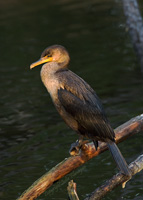Description: The Double-crested Cormorant is a large, dark water bird with a long stocky body, long neck, medium-sized tail, webbed feet and a medium sized hooked bill. Immature cormorants have a pale upper breast and throat. The chest varies from nearly whitish to dusky; usually the chest is pale and the belly dark, but may be uniform pale below. The bill of a juvenile will be mostly orange or yellowish. It has a body length of between 70–90 cm (28–35 in) long, with a wingspan of between 114–132 cm (45–52 in). Double-crested Cormorants weigh between 1200–2500 g (42.36–88.25 ounces). Males and females do not display sexual dimorphism. Habitat: A very common and widespread species, it winters anywhere that is ice-free along both coasts, as far north as southern Alaska (on the west coast) and southern New England (on the east coast). It can be found as far south as Mexico and the Bahamas. It migrates from the coldest parts of its breeding range, such as eastern Canada, and has occurred in Europe as a very rare vagrant, for example in Great Britain, Ireland and the Azores. Breeding: Breeding occurs in coastal areas as well as near inland rivers and lakes. They build stick nests in trees, on cliff edges, or on the ground on suitable islands. They are gregarious birds usually found in colonies, often with other aquatic birds, and have a deep, guttural grunt call. Behavior: The Double-crested Cormorant swims low in the water, often with just its neck and head visible, and dives from the surface. It uses its feet for propulsion and is able to dive to a depth of 1.5–7.5 m (5–25 feet) for 30–70 seconds. After diving, it spends long periods standing with its wings outstretched to allow them to dry, since they are not fully waterproofed. This species flies low over the water, with its bill tilted slightly upward, sometimes leaving the colony in long, single-file lines. Diet: Food can be found in the sea, freshwater lakes, and rivers. Like all cormorants, the double-crested dives to find its prey. It mainly eats fish, but will sometimes also eat amphibians and crustaceans. Fish are caught by diving under water. Smaller fish may be eaten while the bird is still beneath the surface but bigger prey is often brought to the surface before it is eaten. Cormorants regurgitate pellets containing undigested parts of their meals such as bones. These pellets can be dissected by biologists in order to discover what they ate. Conservation Status: Least Concern. Interesting Fact(s): The Double-crested Cormorant's numbers decreased in the 1960s due to the effects of DDT. Colonies have also been persecuted from time to time in areas where they are thought to compete with human fishing. Growing in numbers throughout its range, this cormorant is increasingly being blamed for declines in sport fisheries and for devastating fish farms. Source(s): |
Home | Upcoming Events | About Us | Resource Issues | News | Local Contacts Maps | Photos | Publications | Youth Education | FAQ's | Links | Membership |






